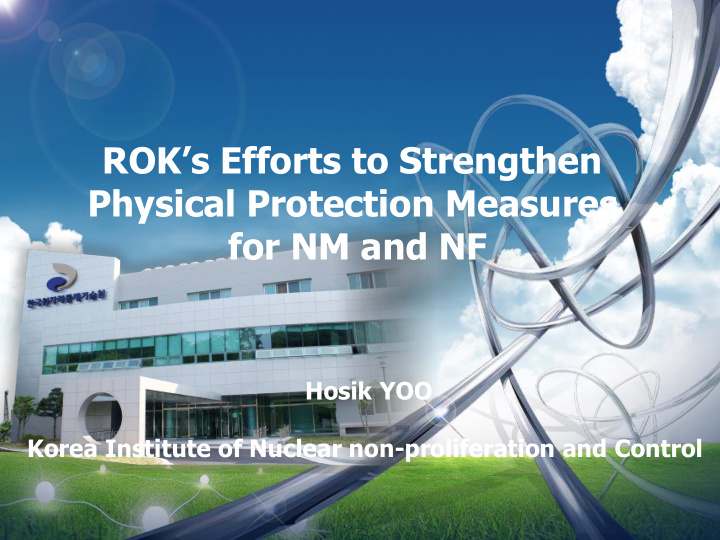



ROK’s Efforts to Strengthen Physical Protection Measures for NM and NF Hosik YOO Korea Institute of Nuclear non-proliferation and Control
Legal Framework APPRE (Act on Physical Protection & Radiological Emergency) • Act for physical protection system of nuclear material & facilities
Revision of the APPRE Ratification of ICSANT and amendment to the CPPNM Ratification process by the national assembly was finished in May 2014. Applying the IAEA INFCIRC225/Rev5 into APPRE Vital area identification Safety-Security Interface Strengthen the penal provisions Invigorate the requirements for protection of NM & NF Amendment of the APPRE for CS Requirements Require licensees to establish cyber security system Require submit a Cyber Security Plan(CSP) for approval
National DBT Threat Assessment and DBT Threat assessment is performed every 3 years and National DBT is revised depending on its results. History Established the 1 st national DBT in 2009 Revised the DBT including cyber threat in 2012 Amended the DBT reflecting air (drone) and sea attack in 2015 Currently, threat assessment document is being reviewed. Post Activities Develop threat scenario based on national DBT Evaluate threat and response scenario through FOF
Vital Area Identification Definition Enforcement Decree of APPRE [Article 2. Definition] : The term “ vital area ” means those areas, in the protected area, fixed for the protection of nuclear facilities, etc. that may produce, directly or indirectly, an unacceptable radiological consequence due to sabotage. INFCIRC-225/Rev.5 (2011) : An area inside a protected area containing equipment, systems or devices, or nuclear material, the sabotage of which could directly or indirectly lead to high radiological consequences (HRC)
Vital Area Identification Problem of current VA in the ROK Designated buildings as VA - Graded approach can not be applied since whole areas such as spent fuel storage building are designated as VA - VA was established only depending on expert judgment Re-Identifying of VA Re-Identifying of Vital Areas of NPP in operation and under construction based on PRA(Probabilistic Risk Assessment) Methodology - Developing technical standards to meet international standards Finished re-identifying of VA on APR 1400 type reactor Currently, OPR-1000 type reactors are in progress
Safety-Security Interface Conflict Conflict : Handling of information (Confidentiality vs. Transparency) Managing conflicts (access control etc.) Synergy Regulatory infrastructure Engineering provisions in design and construction Categorization of radioactive sources Security and management of radioactive sources and materials Emergency & Contingency response plans
Safety-Security Interface Competent Authority NSSC responsible for 3S KINAC KINS Safety Security Activities on interface between safety and security Held regular meeting between KINAC and KINS Exchange regulation information Formulate a working group for I&C area Jointly develop regulation document Plan to joint inspection
Exercise Radiological Emergency Force on Force Security Response Exercise Exercise To mitigate the health and To evaluate and improve the environmental impact of effectiveness of plant security Purpose exposes resulting from program to prevent accidents involving radiological sabotage radioactive materials Frequency Once in 5 years Once in a year Regulators, Operators, Local Regulators, Operators, Participants government, Residents, Response force, etc. Medical Staff, Police, etc.
FOF Security Exercise Initiating FOF Security Exercise Legal framework was prepared by revising the APPRE in 2014 Evaluation system had been developed for 4 years Have performed FOF Security Exercise for nuclear facilities since 2015 FOF Equipment : Advanced MILES system
Regulation on Cyber Security Legal Base and Implementation The APPRE was revised including cyber security regulation in 2014 and regular inspection has been conducted biannually Special inspection is conducted in case of occurring accident Future Plans Reinforcement on cyber security is on going through 7 steps Step 1 Step 2 Step 3 CST CDA DID, Incident Step 4 Composition Identification Response Media Control Step 7(Q4,'18) Step 6 Step 5 Technical Operational Integrity Controls Controls Control
Nuclear Security Culture Efforts for enhancing nuclear security culture Establish policy and guidelines on nuclear security culture Perform outreach activities Mandatory Training Program Prepare legal base for mandatory training program in 2012 All the staff who work in nuclear facility should take mandatory training program every year Security staff should take 4 hours in a year with hands on subject Other staff should take 2 hours in a year through e-learning system
Concluding Remarks Efforts for Strengthening Nuclear Security in the ROK Prepare legal base through revising the APPRE reflecting international requirements such as ICSANT, amendment to CPPNM and INFCIRC/225/Rev.5 Re-identifying VA is under progress Perform activities to improve the synergy between safety and security Conduct the FOF security exercise Initiate cyber security regulation Future Plans Strengthen Cyber Security through 7-Step implementation Prepare specific protection measures on insider threat, NMAC and new threats like EMP and drone Establish the regulation systems on nuclear facilities’ life cycle
Recommend
More recommend